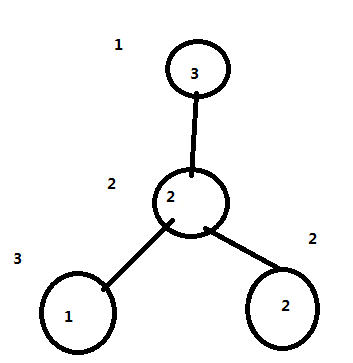[Bzoj4817] [Sdoi2017]树点涂色 (LCT神题)
2018-03-22 08:53
465 查看
4817: [Sdoi2017]树点涂色
Time Limit: 10 Sec Memory Limit: 128 MB
Submit: 629 Solved: 371
[Submit][Status][Discuss]
Description
Bob有一棵n个点的有根树,其中1号点是根节点。Bob在每个点上涂了颜色,并且每个点上的颜色不同。定义一条路 径的权值是:这条路径上的点(包括起点和终点)共有多少种不同的颜色。Bob可能会进行这几种操作: 1 x: 把点x到根节点的路径上所有的点染上一种没有用过的新颜色。 2 x y: 求x到y的路径的权值。 3 x y: 在以x为根的子树中选择一个点,使得这个点到根节点的路径权值最大,求最大权值。 Bob一共会进行m次操作
Input
第一行两个数n,m。 接下来n-1行,每行两个数a,b,表示a与b之间有一条边。 接下来m行,表示操作,格式见题目描述 1<=n,m<=100000
Output
每当出现2,3操作,输出一行。 如果是2操作,输出一个数表示路径的权值 如果是3操作,输出一个数表示权值的最大值
Sample Input
5 6 1 2 2 3 3 4 3 5 2 4 5 3 3 1 4 2 4 5 1 5 2 4 5
Sample Output
3 4 2 2
题解:
其实这道题考的十分妙啊,对LCT的虚实边性质进行了充分的利用。我们读完题发现操作2可以很快想到树剖,操作3可以维护dfs序在线段树上查询子树信息。 但是操作1并不是树剖能解决的; 再来看看操作1的特点 :每次只会修改一种从未出现的颜色,并且一定是从当前点修改到根节点。 然后神奇的操作就来了 : 一开始我们按原树建出lct,只是lct中全部都是虚边,一个点到根节点不同 颜色数量就是它往上到根节点经过虚边数量+1。 每次操作1相当于就是以把当前点accees上去,这样同样颜色的就以实边连在一起了。是不是很神奇。。 然后再来看看怎么统计答案,我们看看lct中什么时候会变虚实边关系,当然就是access了。 access时我们有一句话ch[x][1] = y ,直接把x原来的右儿子覆盖了,变成了新的右儿子, 那么y的虚实关系从虚转为了实,只用找到y中最浅的一个点,对它子树全部贡献-1即可。 然后原来的右儿子从实变为了虚,找到它最浅的一个点,对它子树全部贡献+1即可。 然后我们来看看操作2,是对一条路径进行查询,并不能用树剖做。 但是我们发现一个性质,因为每次修改的颜色都是新的颜色,并且是从当前点修改到根节点,设lca(u,v) != u && lca(u,v) != v 那么u和v一定颜色不同,我们只需要在线段树上单询ask(u) + ask(v) - 2 * ask(lca(u,v)) + 1 即可 但为什么要加那个1

如图,我们查询左下角颜色为1点和右下角的颜色为2的点;当lca颜色和它们不同时发现lca的颜色减多了,要加回来。

当lca和其中一个相同时,我们发现还是减多了,还是得加回来。
一条链的情况自己画图也是同理的。这样对于操作2就用线段树轻松维护了。
操作3????不就是线段树dfs序查询子树吗。
这样我们就神奇的利用了LCT的性质把一道看似树剖的题做成了LCT神题。。
AC代码:
过了样例直接交,一遍交过的酸爽
# include <iostream>
# include <cstdio>
# include <cstring>
using namespace std;
const int N = 2e5 + 12;
int st
,ed
,fa
,ch
[2],s[N << 2],la[N << 2],n,m,head
,dt;
struct Edge{
int to,nex;
}edge[N << 1];
void AddEdge(int u,int v)
{
edge[++dt] = (Edge){v,head[u]};
head[u] = dt;
}
bool isroot(int x){return ch[fa[x]][0] != x && ch[fa[x]][1] != x;}
void rotate(int x,int d)
{
int pre = fa[x],g = fa[pre],nex = ch[x][d];
ch[pre][d ^ 1] = nex;
if(nex)fa[nex] = pre;
fa[x] = g;
if(!isroot(pre))ch[g][ch[g][1] == pre] = x;
ch[x][d] = pre;
fa[pre] = x;
}
void splay(int x)
{
int pre,g;
while(!isroot(x))
{
pre = fa[x],g = fa[pre];
if(!isroot(pre) && !((ch[pre][0] == x) ^ (ch[g][0] == pre)))rotate(pre,ch[pre][0] == x);
rotate(x,ch[pre][0] == x);
}
}
int find(int x){while(ch[x][0])x = ch[x][0];return x;}
void push(int x){s[x] = max(s[x << 1],s[x << 1 | 1]);}
void down(int x)
{
s[x << 1] += la[x];s[x << 1 | 1] += la[x];
la[x << 1 | 1] += la[x];la[x << 1] += la[x];
la[x] = 0;
}
void updata(int L,int R,int l,int r,int rt,int d)
{
if(L <= l && r <= R){s[rt] += d;la[rt] += d;return;}
down(rt);int mid = l + r >> 1;
if(L <= mid)updata(L,R,l,mid,rt << 1,d);
if(R > mid)updata(L,R,mid + 1,r,rt << 1 | 1,d);
push(rt);
}
int Query(int L,int R,int l,int r,int rt)
{
if(L <= l && r <= R)return s[rt];
down(rt);int mid = l + r >> 1;
if(L > mid)return Query(L,R,mid + 1,r,rt << 1 | 1);
if(R <= mid)return Query(L,R,l,mid,rt << 1);
return max(Query(L,R,l,mid,rt << 1),Query(L,R,mid + 1,r,rt << 1 | 1));
}
int ask(int x){return Query(st[x],st[x],1,n,1);}
void access(int x)
{
int y = 0,t;
while(x)
{
splay(x);
if(t = find(ch[x][1]))updata(st[t],ed[t],1,n,1,1);
ch[x][1] = y;if(t = find(y))updata(st[t],ed[t],1,n,1,-1);
y = x;x = fa[x];
}
}
int hson
,sz
,tot,top
,dep
,Fa
,id
;
void dfs(int u)
{
sz[u] = 1;
for(int i = head[u];i;i = edge[i].nex)
{
if(sz[edge[i].to])continue;
Fa[edge[i].to] = u;
dep[edge[i].to] = dep[u] + 1;
dfs(edge[i].to);
sz[u] += sz[edge[i].to];
if(sz[hson[u]] < sz[edge[i].to])hson[u] = edge[i].to;
}
}
void dfs(int u,int tp)
{
top[u] = tp;st[u] = ++tot;id[tot] = u;
if(hson[u])dfs(hson[u],tp);
for(int i = head[u];i;i = edge[i].nex)
if(!st[edge[i].to])dfs(edge[i].to,edge[i].to);
ed[u] = tot;
}
int lca(int x,int y)
{
while(top[x] != top[y])
{
if(dep[top[x]] < dep[top[y]])swap(x,y);
x = Fa[top[x]];
}
return dep[x] < dep[y] ? x : y;
}
int Q1(int u,int v){return ask(u) + ask(v) - 2 * ask(lca(u,v)) + 1;}
int Q2(int u){return Query(st[u],ed[u],1,n,1);}
int main()
{
scanf("%d %d",&n,&m);int tp,x,y;
for(int i = 1;i < n;i++)
{
scanf("%d %d",&x,&y);
AddEdge(x,y);AddEdge(y,x);
}
dfs(1);dfs(1,1);
for(int i = 1;i <= n;i++)updata(st[i],ed[i],1,n,1,1),fa[i] = Fa[i];
while(m--)
{
scanf("%d",&tp);
if(tp == 1)scanf("%d",&x),access(x);
if(tp == 2)scanf("%d %d",&x,&y),printf("%d\n",Q1(x,y));
if(tp == 3)scanf("%d",&x),printf("%d\n",Q2(x));
}
}
相关文章推荐
- [LCT] BZOJ 4817 [Sdoi2017]树点涂色
- BZOJ 4817 [Sdoi2017]树点涂色 ——LCT 线段树
- 【BZOJ4817】【SDOI2017】树点涂色 [LCT][线段树]
- [BZOJ4817][SDOI2017]树点涂色(DFS序+LCA+树剖+LCT)
- bzoj4817 [Sdoi2017]树点涂色
- 【BZOJ4817】[Sdoi2017]树点涂色 LCT+线段树
- bzoj4817 [Sdoi2017]树点涂色
- BZOJ4817 [Sdoi2017]树点涂色(洛谷P3703)
- [BZOJ4817][SDOI2017]树点涂色(LCT+DFS序线段树)
- [bzoj4817][Sdoi2017]树点涂色
- [BZOJ4817][SDOI2017]树点涂色(LCT+线段树+差分)
- bzoj4817 [Sdoi2017]树点涂色
- [BZOJ4817][SDOI2017]树点涂色
- Bzoj4817 [Sdoi2017]树点涂色
- BZOJ4817 [Sdoi2017]树点涂色
- 【BZOJ4817】树点涂色(LCT,线段树,树链剖分)
- 【bzoj4817】[Sdoi2017]树点涂色 LCT+LCA+线段树
- 【BZOJ4817】树点涂色(LCT,线段树,树链剖分)
- 【XSY2534】【BZOJ4817】树点涂色 LCT 倍增 线段树 dfs序
- 【BZOJ4817】【SDOI2017】树点染色
